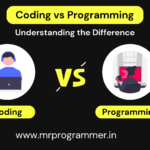Have you ever thought What Is the Difference Between a Programming Language and Natural (Every-Day) Language? In this blog post, you will learn about the differences between these two linguistic domains, which show their structures, functions, and applications.
Also Read: How to Start a Coding Career in 2024 With No Experience
In the complex world of communication, two main forms of languages exist programming and natural languages (which we use in our everyday lives). While both serve the purpose of facilitating communication, they are used in different areas.
1. Definition and Purpose
| Programming Language | Natural Languages |
|---|---|
| A formalized set of instructions used to communicate with computers. | A system of communication developed by humans for everyday interactions. |
| Designed for specific tasks such as coding and commanding a computer to perform actions. | Evolved organically to express thoughts, emotions, and ideas among individuals. |
Programming languages are crafted with precision and specificity to provide a set of commands that a computer can understand and execute. Whereas, natural languages are dynamic and adaptable, serving as the primary mode of communication among people in various contexts.
2. Structure and Syntax
| Programming Language | Natural Languages |
|---|---|
| Rigid and structured with defined syntax rules. | Flexible and context-dependent with varied grammar rules. |
| Utilizes specific keywords and symbols for precise communication | Allows for ambiguity, context-dependent meanings, and nuances. |
| Examples: Python, Java, C++ | Examples: English, Hindi, Spanish |
Programming languages demand careful observation of syntax and structure to ensure that instructions are conveyed accurately to a computer. Natural languages, on the other hand, thrive on flexibility and adaptability, allowing for diverse expressions and interpretations.
3. Communicative Audience
| Programming Language | Natural Languages |
|---|---|
| Directed towards machines (computers) for the purpose of coding and automation. | Primarily intended for human-to-human communication. |
| Machines interpret and execute instructions based on the programmed logic. | Humans translate meaning through contextual understanding and cultural nuances. |
Programming languages instruct exclusively to computers, acting as intermediaries between human intentions and machine actions. In contrast, Natural languages serve as the foundation for human connection, enabling the exchange of ideas, emotions, and information.
4. Uncertainty and Precision
| Programming Language | Natural Languages |
|---|---|
| Aims for clarity with a simple syntax for interpretation. | Evolves organically over time, influenced by cultural, social, and regional factors. |
| Prone to errors if syntax rules aren’t strictly followed. | Language evolution is shaped by societal changes, global interactions, and cultural |
Programming languages demand precision to avoid errors in code execution, as computers cannot interpret unclear instructions. Natural languages, however, enable individuals to convey complex thoughts and emotions through contextual signals.
5. Evolution and Adaptability
| Programming Language | Natural Languages |
|---|---|
| Constantly evolving to accommodate new technologies and paradigms. | Evolves organically over time, influenced by cultural, social, and regional factors. |
| New programming languages emerge to address specific computing needs and advancements. | Language evolution is shaped by societal changes, global interactions, and cultural shifts. |
Programming languages adapt to the ever-changing landscape of technology, introducing new syntax and features to meet emerging demands. Natural languages evolve organically, reflecting the strength of human societies and their interactions.
Conclusion
In conclusion, the distinction between programming languages and natural languages lies not only in their functions but also in their structures, adaptability, and intended audiences. While programming languages provide the precision necessary for computer communication, natural languages serve as the versatile mode that brings together the world of human interaction. Recognizing and appreciating the uniqueness of each form of language is crucial to understanding their respective roles in our technology driven and socially connected world.
- I Tried ChromeOS Flex After Switching From Windows 10 - October 13, 2025
- Top 5 Business Skills Every Programmer Needs to Get Hired (2025 Guide) - August 27, 2025
- Intel’s Downfall? How a Silicon Titan Lost the Plot—and What Comes Next - August 26, 2025







